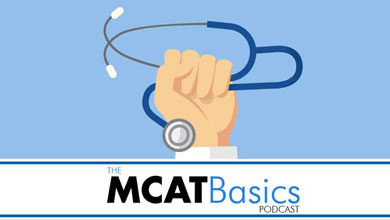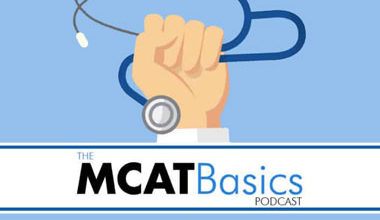The MCAT Basics Podcast begins a new series on Metabolism, and in today’s episode, Alex Starks talks about Glycolysis. The series covers the chemistry, biochemistry, and biology of glucose metabolism and how this high-yield MCAT topic can be tested on the AAMC MCAT Exam.
- [00:55] Metabolism for the MCAT
- [05:20] Insulin-dependent Cells
- [06:25] Cellular-level Catalyzation of Glucose
- [09:57] Glycolysis Explained in 10 Steps
- [21:50] The Presence and Absence of Oxygen During Respiration
- [25:35] Quiz and Important Takeaways
Metabolism for the MCAT
Broadly defined, metabolism is all about energy and the transfer of electrons. So, everything you consume is broken down through a series of complex chemical processes to release energy. There are two basic types of metabolic processes: catabolism and anabolism. Catabolism is the process of obtaining energy from nutrients, while anabolism is the production of new cell components. Today we’ll focus more on the carbohydrate metabolism that typically starts in the mouth.
During carbohydrate breakdown of, say, a slice of bread, amylase, a key enzyme found in saliva, is involved in the hydrolysis of large polymeric carbohydrates into smaller units: monosaccharides and disaccharides. As you all probably know, nothing really happens to carbohydrates in the stomach, so the next action center is the duodenum. Here, the monosaccharides and disaccharides are further broken down into glucose that is absorbed into the bloodstream.
The high-yield point you should note here is that once glucose is absorbed into the bloodstream, it goes directly into the liver. If glucose concentration in the bloodstream is above a specific threshold, the liver moves the excess glucose into the cells and vice versa. The glucose transporter then circulates glucose throughout the body organs and maintains a consistent supply to the brain.
Insulin Dependent Cells
At this point, the skeletal muscles and fat cells are unable to pick glucose through the liver. And so, we go back to the pancreas, where another glucose transporter process can be seen. Insulin is produced when high blood glucose levels promote anabolic pathways, such as glycogenesis, fatty acid synthesis, and peptide synthesis. The skeletal muscles and fat cells receive energy through these pathways only when glucose is in excess in the bloodstream. And this makes sense because we wouldn’t want a situation where fat and muscle cells absorb energy before crucial organs such as the brain get their share.
Glycolysis Explained in 10 Steps
Glycolysis is divided into two phases: the preparatory phase and the payoff phase. Both phases contain five additional steps that explain how glucose is converted into pyruvate, ATP, and NADH.
Step 1: The first step in glycolysis is the conversion of D-glucose into glucose-6-phosphate. The enzyme that catalyzes this reaction is hexokinase. Hexokinase requires Mg2+ to catalyze the reaction.
Step 2: The second step involves rearranging glucose 6-phosphate (G6P) into fructose 6-phosphate (F6P) by glucose phosphate isomerase.
Step 3: Fructose 6-phosphate + ATP releases Fructose 1,6-bisphospate + ADP, a non-reversable reaction catalyzed by Phosphofructokinase-1.
Step 4: Aldolase sparks a reaction where fructose 1,6-biphosphate releases Glyceraldehyde 3-phosphate and Dihydroxyacetone
Step 5: In step 5, triosephosphate isomerase rapidly inter-converts the dihydroxyacetone phosphate (DHAP) and glyceraldehyde 3-phosphate (GAP) molecules.
Step 6: Step 6 is the first step of the payoff phase and involves the oxidation of Glyceraldehyde 3 phosphate to 1,3, Bisphosphoglycerate.
Step 7: In step 7, phosphoglycerate kinase transfers a phosphate group from 1,3-bisphosphoglycerate to ADP to form ATP and 3-phosphoglycerate.
Step 8: This step is all about the conversion of 3 phosphoglycerates to 2 phosphoglycerates, a reaction catalyzed by Phosphoglycerate mutase.
Step 9: Step 9 is called the dehydration of 2 phosphoglycerates to phosphoenolpyruvate. Enzyme enolase removes a molecule of water from 2-phosphoglycerate to form phosphoenolpyruvic acid.
Step 10: Pyruvate kinase catalyzes the last reaction of glycolysis where the phosphoryl group is released from phosphoenolpyruvate, joins with ADP, and sparks ATP production.

